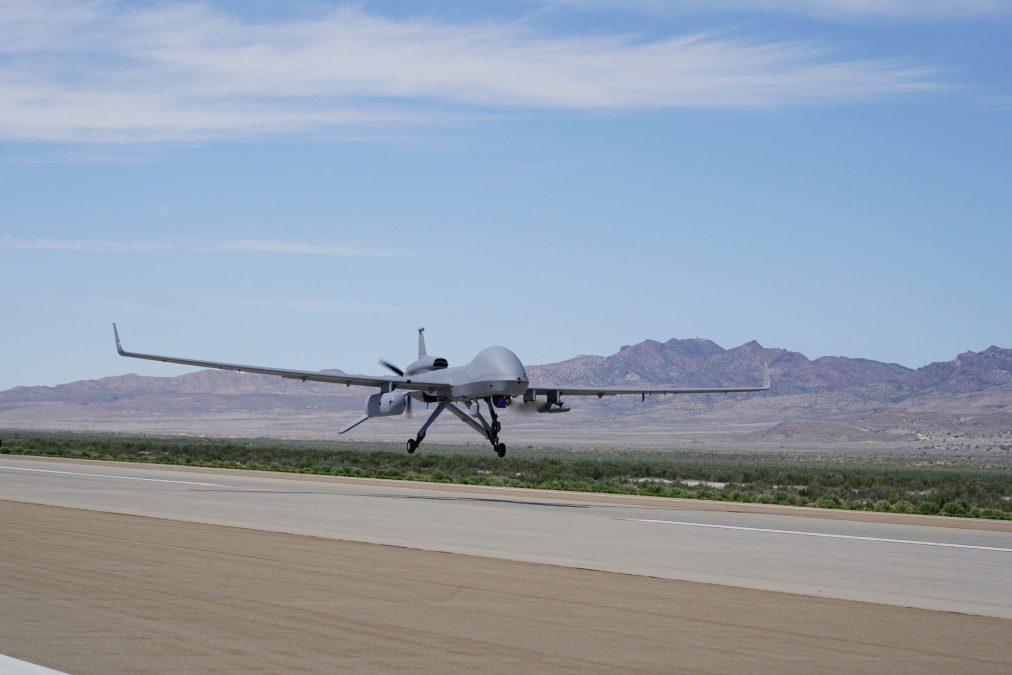General Atomics adding AESA radar and software to upgraded Gray Eagles

Unmanned systems manufacturer General Atomics announced it is adding an Active Electronically Scanned Array antenna to its EagleEye multi-mode radar that will be installed on Gray Eagle 25M systems.
General Atomics, which produces large unmanned systems capable of flying for long periods at altitudes of 29,000-to-50,000 feet, believes the AESA will increase the range of its systems and provide more enhancements.
“We expect the AESA antenna to more than double the range for EagleEye,” Jeff Hettick, General Atomics vice president of agile mission systems, said in a release. “The increased range and optimized multi-mode performance of the radar are perfectly tailored to provide deep sensing capability in Multi-Domain Operations (MDO). That will allow the aircraft to operate well outside Weapons Effects Zone of most threat systems adding a layer of survivability supporting the Stand-Off survivability with Stand-In effects of long-range sensors.”
The military expects conflicts against potential near-peer and sophisticated nation-states to take place over greater distances than those during the war on terror. As a result, the Army, in particular, has talked about the requirement for so-called “deep sensing” to develop targets and shoot them accurately across thousands of miles.
Advanced enemy radar, anti-aircraft capabilities and long-range missiles will likely push U.S. assets farther away from their targets than in the past, necessitating the need to collect inside that so-called weapons engagement zone. Capabilities such as the Gray Eagle, which can fly at around 25,000 feet, can see over the horizon and above the curvature of the Earth to conduct intelligence and collect certain enemy capabilities.
The AESA antenna will be a “drop-in” hardware upgrade to the EagleEye, the company said, providing associated software with the system as well.
The upgrades will be housed on the Gray Eagle 25M, a part of the Gray Eagle modernization for the Army. The Army has been flying MQ-1C Gray Eagles for over a decade, with newer variants for longer range and power being provided through the years. The 25M provides up to five times more processing capacity and 80 times more data storage for increased computing power enabling processing at the edge, the company said, first testing its flight in December 2023.
Company officials stated that General Atomics is investing in its EagleEye product specifically for the Army. The company currently supports the Army’s interim synthetic-aperture radar requirements as part of the 25M configuration, though the new product enhancement has not been selected yet.
The addition of an AESA antenna is significant given the increased capabilities it provides both from a sensing and effects perspective. The radars are much more powerful and more capable than legacy systems enabling many more signals across a wider distance. Their ability to beam signals also enables the capability to produce non-kinetic effects in the radio-frequency sphere, such as limited electronic attack and cyber capabilities over radio frequency.
When Special Operations Command had sought AESA radars on some of its platforms, the commander of Air Force Special Operations Command at the time noted that capability “opens up a host of possibilities for everything from airborne electronic attack and airborne cyber effects and things of that nature that up to now have not been part of our portfolio,” according to The War Zone.
General Atomics declined to talk specifics about the system’s electronic warfare and cyber capabilities, only offering that it is correct to assert the company is focused on keeping not only mission systems but the whole aircraft as relevant as possible ahead of potential threats.
Lockheed Martin is producing an external pod for the Army that will be mounted aboard Gray Eagles to conduct airborne electronic warfare — with limited cyber capability — organic to combat aviation brigades. While this pod will be specially outfitted for these missions and limited, AESA capabilities resident on a platform provide the platform organic capabilities, albeit not as powerful as external systems.
Overall, the company states the AESA antenna and associated software for EagleEye will provide significant performance enhancements, particularly in range and mode.
“This is a key component of the Gray Eagle 25M (GE 25M) Unmanned Aircraft System being developed for the U.S. Army,” said C. Mark Brinkley, a company spokesman. “We know these enhancements make the EagleEye radar a better, more capable product. Which is what our customers want.”



